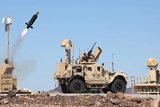UK, Italy and Japan tie the knot with joint fighter project
A rendering of the Global Combat Air System future fighter jet flying over Japanese skies. (Image: BAE Systems)
The UK, Japan and Italy have announced a new partnership under the Global Combat Air Programme (GCAP) to develop a trilateral next-generation fighter jet.
The announcement follows joint-concept studies by Rome, London and Tokyo launched during this year's Farnborough Air Show in July.
The deal sees work on the UK-led Tempest Future Combat Air System (FCAS), and Japan's F-X future fighter programme come together.
The GCAP project will have no lead nation or company overall. The programme will be of equal partnership with BAE Systems heading development on behalf of the UK, Leonardo for Italy and Mitsubishi Heavy Industries for Japan.
Already have an account? Log in
Want to keep reading this article?
More from Air Warfare
-
![How do we detect and defeat enemy drones?]()
How do we detect and defeat enemy drones?
Learn about the portfolio of sensors and effectors for the complete counter-UAS mission at Raytheon, an RTX business.
-
![BAE Systems lauds counter-UAS drone progression with live fire trials]()
BAE Systems lauds counter-UAS drone progression with live fire trials
The US-based tests successfully demonstrated the first live trial of a precision guided missile from a modified TRV-150 drone which destroyed both aerial and ground targets.
-
![Kratos Defense makes European CCA push with Airbus partnership]()
Kratos Defense makes European CCA push with Airbus partnership
Kratos’ XQ-58A Valkyrie will be equipped with an Airbus-made mission system to be offered as a ‘European’ collaborative combat aircraft option to the German Air Force.






















